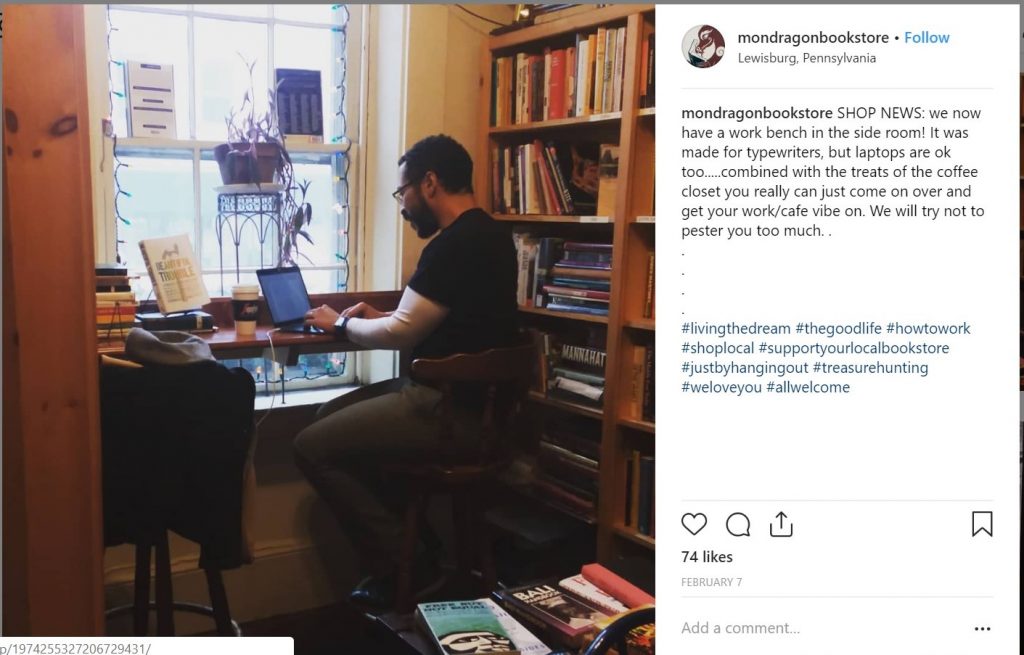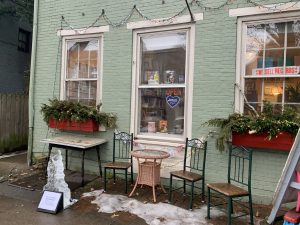When I first walked through the door of Mondragon Books, I didn’t know where to begin. I wasn’t looking for anything in particular, but even if I had been, I think I still would have been temporarily stumped. It was like walking into a whole other world. The store opened up before me with a couch in the center of the first room and artwork on the opposite wall and all around me were full bookshelves that stretched all the way up to the ceiling.
I was struck by the realization that Mondragon didn’t feel like a store. There was something else going on here, something that simultaneously made me feel both endeared to this place and a bit intimidated by it.
This feeling, the one I couldn’t quite put my finger on yet, is what made me move immediately from this first room into the second one. Through something that could barely be called a hallway and on the left was a room more simplistic than the first one, with walls lined solely with floor to ceiling bookshelves, and a work bench pressed against a window. I fondly refer to this room as the “history” one, and while its shelves do house US history books, there is also a section for economics, travel, and international books. Most notably, set against the window that faces outward toward Lewisburg, is a desk encouraging people to sit down with a cup of coffee from the coffee closet and do work or relax.

Moving in to the middle room, past the tiny restroom and coffee closet, two cushy chairs could be found surrounded by, you guessed it, more incredible bookshelves. This room almost seemed to be the culture room, with books on religion, spirituality, film, and theater spread throughout. This is also the room with a phone set against the wall, like the house phone you probably had before it was swapped out for cell phones.
Walking through the store continued to feel like flowing through the heart of something. Following the hallway situated behind the checkout desk lead to what can generally be called the fiction section, but there wasn’t solely fiction. There were also books of short stories, poetry, books for kids, young adult books, and records.
I can’t help but recognize the thoughtfulness that went into putting the fiction all the way in the back of the store. Sarajane said once that Mondragon doesn’t prioritize carrying popular fiction, but it requires no stretch of the imagination to assume that a large portion of the books going out of Mondragon’s doors in the hands of customers are works of fiction. Why not show those customers what else Mondragon has to offer by giving them the opportunity to wind their way through the rest of the store, passing books on history and graphic novels, and cultural studies as they move to the fiction section in the back room? From a business standpoint, it’s a good move. Maybe someone will pick up an extra book on the way, and leave with two or three instead of just the one they came in looking for.
This, to me, was the only reminder that Mondragon was a store.
It was moving back to the first room (after, to be honest, a rather extended period of time spent browsing the shelves of the fiction section) and seeing the section tucked into the far right corner labeled Sex, Life, and Death, that I was finally able to put my finger on what it was about Mondragon that had given me that initial strange feeling.
Intimacy.
It was the intimacy of this place that made it not feel like a store. Intimacy that came through the fact that the building looked, both on the outside and the inside, like someone’s home.

It was the intimacy of the couch in the middle of the front room, with Tiger the cat sitting in it, that invited visitors to come sit with a book or homework and exist quietly in this space.
It was the intimacy of the artwork on the walls, which Sarajane, in a later visit, explained were made by people who had visited Mondragon on one of its art nights, where people gather around the store and make art together.
I felt strange walking into Mondragon that first time because it felt like walking in to someone’s home.
Not only does Mondragon feel like someone’s home, it feels like someone’s collection. Specifically, Sarajane’s collection. While on a visit in which my group got a chance to chat with Sarajane, someone came with a box of books they wanted to donate. Sarajane explained to us that this is how Mondragon works: People donate books, and Sarajane chooses which books to keep to sell in the store and which ones to re-donate somewhere else. She joked that, sometimes, it isn’t all up to her. She has a friend who goes through the re-donate pile, and will occasionally chastise her for getting rid of a certain book. However, the understanding was that it was Sarajane’s decision at the day as to what was allowed to briefly call Mondragon home.
It makes me think of what Walter Benjamin wrote in his essay “Unpacking My Library.” He said, “For what else is this collection but a disorder to which habit has accommodated itself to such an extent that it can appear as order” (Bejamin, 60). This seems to be what has happened at Mondragon. Sarajane has created order within these four little rooms. The next page over, he also writes, “I am not exaggerating when I say that to a true collector the acquisition of an old book is its rebirth” (Benjamin, 61). I think it is safe to assume that this is the mentality Sarajane has, given her excitement when those donated books came through the door.
Sarajane organized the books in a particular way, one example being the fiction section. But I think a more interesting example is in the fact that she put the US history section right next to the travel and international sections, almost as if she’s encouraging her customers to branch out, explore, and learn as much as they can.
In the end, I got used to the intimacy at Mondragon. I think I can even say I grew to love it, from the art on the walls, to the chairs in every room that made you want to curl up with a good book, to the tea and coffee closet and the landline on the wall. Mondragon is Sarajane’s passion project. Even if she wasn’t its founder, it is very much hers now, because she made it into what it is today. Its through Sarajane’s collection, as we browse and meander and read our hearts out, that I think we learn a bit about Sarajane, and maybe even a bit about ourselves.
Works Cited:
Article
Benjamin, Walter. “Unpacking My Library.” Illuminations, Schocken Books, 1969, pp. 59–67.
Map:
Created by Sarajane Snyder
Additives by Thinglink
Photos:
Photos in Thinglink courtesy of mondragonbookstore Instagram and Mac Bowers
Photo of the side room courtesy of mondragonbookstore Instagram
Photo of the front of Mondragon courtesy of Mac Bowers

0 Comments